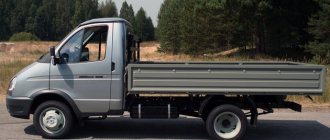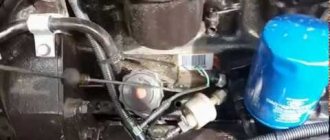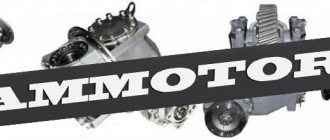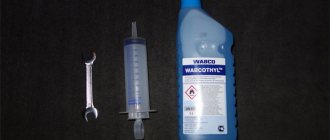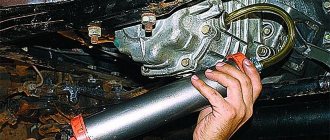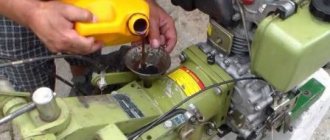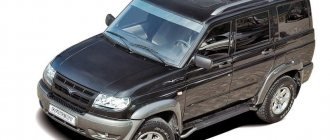One and a half ton truck GAZ-3302
There were practically no small commercial vehicles in the USSR, and of the relatively small trucks in the Soviet Union, only the GAZ-AA “lorry” was produced.
But by 1950, production of the legendary truck was discontinued; subsequently, cargo was transported only by vehicles with a carrying capacity of at least two tons, and the dimensions of such vehicles were impressive. The need for transportation of small consignments of goods and cargo arose with the development of the market in Russia; the first in the class of light commercial vehicles (LCV) was the Gazelle. At first, the one and a half ton GAZ-3302 vehicles were equipped with ZMZ-402 (Ai-92) and ZMZ-4021 (A-76) engines, mechanical 4- and 5-speed gearboxes, and a “Tchaikovsky” rear axle. The cabin was designed for three people, including the driver; the lorry could be equipped with an awning, which all on-board vehicles were equipped with from the factory.
The four-speed gearbox was frankly weak for a light-duty truck, and by 1996 the plant stopped installing them; cars were now equipped with only a 5-speed gearbox. Manual transmission. Also around this time, a bridge of its own design was developed for Gazel, and the Tchaikovsky (type GAZ-3102) was removed from the production line. In 1997, the car went into production with a carburetor 110-horsepower internal combustion engine ZMZ-4063.10.
In the entire history of its existence, the GAZ-3302 was restyled only twice - in 2003 and 2010, and since 1995, the all-wheel drive truck 33027 has been produced. In the last year of the pre-restyling version (2002), the production of vehicles with an extended frame began, the chassis received the index 330202. Although the vehicle's carrying capacity remained almost the same, it was already possible to transport long loads on a vehicle with an extended body. The technical characteristics of the GAZ-3302 (model 1994-2003) are as follows:
- number of doors – two;
- number of passenger seats (including passenger seat) – 6;
- body type – pickup;
- load capacity – 1500 kg;
- wheelbase – 290 cm;
- curb weight – 1600 kg;
- rear/front wheel track – 156/170 cm;
- maximum weight of a loaded vehicle (total weight) – 3.5 tons;
- dimensions (length/width/height) – 5,120/1,970/2,120 m (height is taken from the cabin, excluding the awning);
- ground clearance (clearance) – 17 cm;
- wheel rim radius – R16;
- tire size – 175/80;
- gas tank volume – 60/70 liters, depending on the vehicle modification;
- front/rear suspension - dependent, on leaf springs.
It should be noted that the first Gazelles were equipped with 60-liter plastic fuel tanks, and only later they decided to install 70-liter metal gas tanks. On the rear axle of the onboard GAZ-3302 there are two ramps on each side, the rear axle is mounted on springs.
Video review
In terms of technical characteristics, the GAZ-2705 is one of the best in its class and is suitable for almost any consumer. The high-strength frame highway is highly resistant to any type of deformation, which allows the vehicle to be used not only on asphalt roads, but also on dirt roads and off-road. A special all-wheel drive modification of the GAZ-2705 is offered for farmers. Currently, the Gorky Automobile Plant produces over 60 versions of the car, differing in “filling” and overall characteristics.
All-metal vans built on the basis of this vehicle are designed as standard for 3 people. The “combi” design allows you to accommodate up to 6 people (the cabin is separated from the compartment by a blank wall). Increased demand for the model forces the Gorky Automobile Plant to regularly carry out changes and restyling of the car, improving its basic parameters.
Most of the transformations turned out to be minor and concerned individual nodes. So, in the early 2000s, the headlights, radiator and bumper were changed. Major modernization of the GAZ-2705 was carried out twice. Currently, the Gazelle is in its third generation.
This modification is both maneuverable and roomy, which makes it easier to transport goods in difficult urban conditions. Loading the car is quite simple: either through the sliding side door or through the rear hinged doors. The model has a loading height of 725 mm. The durability of the all-metal body is ensured by the use of advanced equipment used in the painting and welding process. The design of the van ensures driver comfort and increased cargo safety.
Reliable power plants of the Gazelle are combined with a 5-speed synchronized gearbox, created on the basis of a 4-speed gearbox from Volga.
Low cost coupled with low operating costs makes the GAZ-2705 an excellent option for small businesses.
The appearance of the model
How much and what kind of oil should I pour into the gazelle gearbox?
The engine production plant, located in Ulyanovsk, is one of the oldest workshops in Russia. Today, assembly units are part of the commercial organization “Gr. GAZ”, and its formation began in 1941. During wartime, the equipment of an automobile plant located in Moscow and named after I.V. Stalin was moved to Ulyanovsk. From that moment on, the plant was repeatedly renamed and retrained, until in 1968 it received the usual name “UMZ”. It was then that the full-fledged design and assembly of automobile engines began at the enterprise; 1969 was marked by the release of the first engine from the assembly line.
Starting from 1997, Ulyanovsk mastered the production of motors with increased power, which were used on commercial vehicles. The beginning was made by the UMZ-4215 power plant, in which the formation of the mixture occurred through a carburetor. Already in 1998, the product received an updated modification, equipped with an injector and complying with Euro-2 standards. Testing and fine-tuning the product led to the appearance of a new motor, released in 2003. The installation was named engine 4216 and soon began mass production.
The product was used on commercial vehicles produced by Gorky plants, steel cars of the Gazelle brand. After tightening environmental standards and safety requirements, in 2008 the engine was updated to the Euro-3 standard. In 2010, engines began to be installed on updated vehicles of the Gazelle Business series. After some time, the installation was brought up to Euro 4 level (2012), and after being equipped with hydraulic compensators in 2013, it was used on “Next” series machines. In 2014, a turning point came for the Business and Next series cars, as the cars began to be equipped with 2.7-liter Evotech engines.
Special equipment based on Gazelle Business:
Power point
The power unit on the car is ZAZ-406. He has the following data:
- Petrol;
- Injection – injector;
- 4 cylinders, which are arranged in a row;
Engine type GAZ 27057
- 16 valves;
- Power – 145 l/s;
- RPM speed – 5200 per minute;
- Cylinder diameter - 92 mm;
- The piston stroke is 86 mm.
- Weight – 192 kg.
The motor is relatively good with minimal intervention for prevention and a long service life. The big minus is the cooling. Requires frequent fluid changes.
Recently, the plant began installing a new type of Chinese-made CUMMINS engine on the Gazelle, but there are practically no parts for it, and it is also expensive to maintain.
Return to contents
Operating characteristics of the UMZ 4216 engine
Fuse box gazelle 3302 diagram decoding
Gazelle engine 4216 uses input into the supply channels to supply flammable liquid. Manipulations are carried out using gasoline fittings and a sprayer. Feed control adapts to changing conditions thanks to reading sensors, a processing unit for incoming information and actuators. Devices that affect the tuning and stability of operation include: an oxygen sensor located in the exhaust tract and a knock meter located on the head of the engine frame.
Gazelle “Next”, onboard:
Technical characteristics of the UMZ 4216 engine:
| Index: | Meaning: |
| Engine release adjusted | Ulyanovsk city |
| The motor has been produced since | 2003 – today |
| Motor frame material | Aluminium alloy |
| Motor power | injector |
| Number and location of engine chambers | four in a row |
| Operation of engine chambers, order | "One - two - four - three" |
| Valves per engine chamber, (pcs.) | 2 |
| Motor chamber cross-section, (mm) | 100 |
| Motor displacer stroke, (mm) | 92 |
| Motor squeezing | 8,8 |
| Sum of engine cylinder volumes, (l) | 2,89 |
| Motor power, (hp) | 125 |
| Motor impulse, (Nm) | 220 |
| Fuel used by the engine | Gasoline (AI-92) |
| Ecological compliance of the motor | "Euro three" |
| Motor weight, (kg) | 170 |
| Engine fuel consumption, l. per hundred, (GxTxS) | 14x10x11 |
| Loss of engine oil, (grams per 1000 km) | Less than 100 |
| Motor lubricant brand | 5W(30.40); 10W(30.40); 15(20)W-40 |
| Amount of lubricant in the motor, (l) | 5,8 |
| Engine lubricant change period, (km) | 10000 |
| Motor operating temperature, (°C) | 90 |
| Resource, (km) | 250000 |
| Used on cars | GAS |
The fuel consumption of the gazelle business engine UMZ 4216 is subject to a number of factors. The value is influenced by: load on the machine, selected rate of movement, seasonality. For example, in winter the car has to be warmed up, which affects consumption.
Modification of engine 421640 for gas:
GAZ 2705 | Technical fluids and filling volumes
Technical fluids and filling volumes
| Liquid name | Engine | Filling volume, l | Purpose and brand of recommended liquid | Maintenance interval |
| 1.2S | 3,2 | API SL (ILSAC GF-III) | ||
| Engine oil | 1.4S/1.4D/1.5S | 3,75 | SAE10W-30 Low temperature areas: SAE 5W-30 | |
| Liquid volume | 1.2S | 5,2 | Ethylene glycol coolant | |
| in the cooling system | 1.4S/1.4D/1.5S | 7,0 | ||
| Automatic transmission fluid | 1.4D/1.5S | 5,9±0.2 | ESSOJWS3309 or ISU DEXRON III | According to the vehicle maintenance regulations |
| Gear oil for manual transmission | 1.2S | 2,1 | SAE75W-85 | (see service book) |
| 1.4S/1.4D/1.5S | 1,8 | SAE 80W at low temperatures SAE 75W | ||
| Brake fluid | 0,5 | DOT 3 or DOT 4 | ||
| Power steering fluid | 1,1 | DEXRON II-D or DEXRON III | ||
* To ensure optimal performance of your vehicle, always use only the recommended automatic transmission fluid.
automn.ru
Peculiarities
What kind of engine oil to fill in a Hyundai engine, how many liters
The ZMZ 405 engine was repeatedly refined and updated, the version with an injector that meets the Euro 3 standard turned out to be widespread and in demand. The solutions with which the unit was equipped are as follows:
The head of the unit block has lost the idle mechanism.
This made it possible to reduce weight and bolt the unit together with a long structure.
Cylinder head ZMZ 405:
The head seal of the unit block was replaced with a gasket consisting of two layers. The use of a metal seal made it possible to increase the ability to withstand increased gas pressure and prevent oil and liquid leakage from the unit.
Cylinder head gasket:
- The 405 Euro 3 engine is resistant to forces causing deformation. The rigidity of the frame structure is achieved due to the need to tighten the unit with bolts.
- The control is carried out by the accelerator electronics. Elimination of most structural elements of the unit, for example, the idle speed unit, air ducts, accelerator pipes, position sensors, etc.
ZMZ 405 throttle assembly:
A bearing has been added that can automatically tension the drive belt.
ZMZ 405 tension roller:
Elimination of ebb and flow in the space of the unit. Made it possible to make the block even stronger; in addition, transverse slots were used, which increased the cooling of the unit. The Gazelle car, using the 405 engine, received increased reliability and durability. The reduction in toxicity standards has made a breakthrough for the use of the unit on the international market.
Operation and repair manual
The demand for the machine is due to the maintainability and reliability of the design solution. The published repair manual describes the steps and technologies for replacing or restoring equipment.
Common gazelle breakdowns:
- engine overheating (requires replacement of cylinder head gaskets);
- failure of the clutch discs and release bearing (replacement of elements required);
- weak tension of the GRN chains (adjustment is necessary once every 3 months);
- loosening of suspensions (adjustment required);
- gearbox malfunction (can be eliminated by cleaning the clutch elements or replacing equipment), etc.
To prevent damage to the vehicle's chassis, the following operating rules must be followed:
- Overloads are not allowed, it is recommended to comply with the weight indicated in the data sheet;
- It is required to secure cargo properly during transportation.
Gazelle Next: technical specifications
“Next” received a frame, rear axle, exhaust system and fuel tank from Gazelle Business, but the cabin and body are completely new, and a completely different front suspension is also installed. The wheelbase of the second generation GAZ car has increased, and many imported parts are installed on the car. The basic version is considered to be a flatbed truck; its chassis is also available in:
- euroboard (with extended frame);
- isothermal and manufactured goods van;
- small class bus;
- flatbed car with double cabin;
- all-metal van in two versions – three-seater and “Combi”;
- special equipment - fuel tanker, milk tanker, tow truck, sewer truck, etc.
In the basic version (flatbed truck) the Gazelle Next car has the following technical characteristics:
- dimensions (length/height/width) – 5,630/ 2,140/ 2,070 m (height is taken according to the cabin, excluding the awning);
- ground clearance (clearance) – 17 cm;
- number of doors – two;
- number of passenger seats (including driver) – 3;
- rear/front wheel track – 156/175 cm;
- curb weight – 1985 kg;
- wheelbase - 3.145 m (with a long frame - 3.745 m);
- load capacity – more than 1500 kg;
- maximum weight of a loaded vehicle (gross weight) – 3.5 tons;
- body type – pickup;
- tire size – 175/80 (185/75);
- wheel radius – R16;
- gas tank volume – 70 liters;
- The front suspension is of an independent type, the rear is an axle on springs.
Source
Engines Gazelle | All ZMZ, UMZ, Cummins engines, repair
GAZ Gazelle is an extremely popular family of light-duty vehicles, which has been produced since 1994. During such a long production period, the car was modernized, and in 2003 an external restyling was carried out, and in 2010 a more serious and in-depth update took place. The car was updated both externally and internally, and the prefix “Business” appeared near the “Gazelle” inscription. The Gazelle-Business family is still produced today, in parallel with the successor Gazelle-Next. Based on the Gazelle, the short-wheelbase GAZ Sobol is produced.
The Gazelle is powered by gasoline engines ZMZ 402, ZMZ 406, ZMZ 405, UMZ 4216 and Chrysler 2.4, as well as Cummins ISF and GAZ 5602 diesel engines.
You will find out which Gazelle engine is better, more reliable and more durable, what kind of oil to use, the characteristics of these engines, malfunctions, design, tuning, etc. by simply selecting the model you are interested in below.
GAZ 3302 Gazelle. Onboard (1994 - present): GAZ 3302 (engine ZMZ-402) (90 hp) - 2.45 l. GAZ 3302 (engine ZMZ-402) (100 hp) - 2.45 l. GAZ 3302 (engine ZMZ-406) (145 hp) - 2.3 l. GAZ 3302 (engine ZMZ-405) (133 hp) - 2.45 l. GAZ 3302 (UMZ-4216 engine) (107 hp) - 2.9 l. GAZ 3302 (Chrysler engine) (137 hp) - 2.4 l. GAZ Gazelle Economy (99 hp) - 2.9 l. GAZ 3302 Gazelle-Business (UMZ-4216 engine) (107 hp) - 2.9 l. GAZ 3302 (diesel engine GAZ-5602) (110 hp) - 2.1 l. GAZ 3302 Gazelle-Business (120 hp) - 2.8 l. TDGAZ 33023 Gazelle-Farmer (1995 - present): GAZ 33023 (ZMZ-402 engine) (100 hp) - 2.45 l. GAZ 33023 (engine ZMZ-406) (145 hp) - 2.3 l. GAZ 33023 (engine ZMZ-405) (133 hp) - 2.45 l. GAZ 33023 (UMZ-4216 engine) (107 hp) - 2.9 l. GAZ 33023 (Chrysler engine) (137 hp) - 2.4 l. GAZ 33023 Gazelle-Business (UMZ-4216 engine) (107 hp) - 2.9 l. GAZ 33023 (diesel engine GAZ-5602) (110 hp) - 2.1 l GAZ 33023 Gazelle-Business (120 hp) - 2.8 l. TDGAZ 2705 Gazelle. Van (1995 - present): GAZ 2705 (engine ZMZ-402) (100 hp) - 2.45 l. GAZ 2705 (engine ZMZ-406) (145 hp) - 2.3 l. GAZ 2705 (engine ZMZ-405) (133 hp) - 2.45 l. GAZ 2705 (UMZ-4216 engine) (107 hp) - 2.9 l. GAZ 2705 (Chrysler engine) (137 hp) - 2.4 l. GAZ 2705 Gazelle-Business (UMZ-4216 engine) (107 hp) - 2.9 l. GAZ 2705 (diesel engine GAZ-5602) (110 hp) - 2.1 l GAZ 2705 Gazelle-Business (120 hp) - 2.8 l. T.D.
GAZ 3221 Gazelle. Minibus (1996 - present): GAZ 3221 (ZMZ-402 engine) (100 hp) - 2.45 l. GAZ 3221 (engine ZMZ-406) (145 hp) - 2.3 l. GAZ 3221 (engine ZMZ-405) (133 hp) - 2.45 l. GAZ 3221 (UMZ-4216 engine) (107 hp) - 2.9 l. GAZ 3221 (Chrysler engine) (137 hp) - 2.4 l. GAZ 3221 Gazelle-Business (UMZ-4216 engine) (107 hp) - 2.9 l. GAZ 3221 (diesel engine GAZ-5602) (110 hp) - 2.1 l GAZ 3221 Gazelle-Business (120 hp) - 2.8 l. TD <<BACK
wikimotors.ru
GAZ 2705 | Adjustment data, filling containers and fluids
1.8. Adjustment data, filling containers and fluids
| GENERAL INFORMATION |
Valve clearances (mm)
| For engines model 2E* | |
| – intake valves | 0,20 |
| – exhaust valves | 0,20 |
| For engines model 4E-FE** | |
| – intake valves | 0,15 – 0,25 |
| – exhaust valves | 0,31 – 0,41 |
| For engines models 4A-FE and 7A-FE** | |
| – intake valves | 0,15 – 0,25 |
| – exhaust valves | 0,25 – 0,35 |
| For diesel** | |
| – intake valves | 0,25 |
| – exhaust valves | 0,30 |
* on a hot engine ** on a cold engine
Candles
| Nippondenso | NGK | |
| For engines model 2E | W16EXR-U11 | BPR5EY11 |
| For engines model 4E-FE | K16R-U | BKR5EYA |
| For engines models 4A-FE and 7A-FE | K20R-U | BKR6EYA |
Gap between spark plug electrodes (mm)
| Model 2E engine | 1,1 |
| Engine 4E-FE, 4A-FE and 7A-FE | 0,8 |
Belt deflection (used) at a force of 10 kgf
For engines model 2E and 4E-FE
| A. Generator B. Crankshaft C. Air conditioning drive D. Power steering pump E. Coolant pump A. Generator B. Crankshaft C. Air conditioning drive D. Tensioner pulley E. Coolant pump A. Generator B. Crankshaft C. Power steering pump D. Coolant pump |
| 1 | 11,0 – 12,5 |
| 2. | 5,0 – 6,5 |
| 3 | 7,0 – 8,5 |
| 4 | 11,0 – 13,0 |
For engines models 4A-FE and 7A-FE
| A. Power steering pump B. Coolant pump C. Crankshaft D. Air conditioning drive E. Generator |
| 1 | 11,5 – 13,5 |
| 2 | 8,5 – 9,5 |
| 3 | 6,0 – 8,0 |
For diesel engine
| A. Generator B. Crankshaft C. Power steering pump A. Generator B. Crankshaft C. Power steering pump A. Generator B. Crankshaft C. Air conditioning drive |
| 1 | 12,0 – 14,0 |
| 2 | 15,0 – 17,0 |
| 3 | 15,0 – 18,0 |
Engine lubrication Oil volume, l
| For engines model 2E | |
| – with filter | 2,8 |
| - without a filter | 2,6 |
| For engines model 4E-FE | |
| – with filter | 3,0 |
| - without a filter | 2,8 |
| For engines model 7A-FE | |
| – with filter | 3,7 |
| - without a filter | 3,5 |
| For diesel | |
| – with filter | 4,3 |
| - without a filter | 3,6 |
Oil brand
For gasoline engines: multigrade oil of API grade (SG or SH), or ILSAC.
For diesel engines: oil grades no worse than API CD.
Cooling system
| Total capacity, l | |
| For 2E engines | 4,6 |
| For 4E-FE engines | |
| – with manual transmission without air conditioning | 4,9 |
| – with air conditioning | 4,6 |
| – with automatic transmission | 4,7 |
| For engines 4A-FE | |
| – with manual transmission without air conditioning | 5,4 |
| – with air conditioning | 5,0 |
| – with automatic transmission | 5,2 |
| For engines 7A-FE | 5,6 |
| For diesels | 7,0 |
Coolant type
Fluid with antifreeze (ethylene glycol based) or anti-corrosion additives (Toyota Radiator Conditioner fluid or equivalent).
Do not use alcohol-based antifreeze.
Battery
| Serviceable batteries | |
| Electrolyte density at 20° C | |
| On gasoline engines: | |
| – on a fully charged battery | 1,260 |
| – on a partially discharged battery | 1,160 |
| – on a completely discharged battery | 1,060 |
| On diesels: | |
| – on a fully charged battery | 1,280 |
| – on a partially discharged battery | 1,180 |
| – on a completely discharged battery | 1,080 |
Charge current
| Maintenance free batteries | no more than 5A |
| Batteries serviced: | |
| – accelerated charge | no more than 15A |
| – slow charge | no more than 5A |
Clutch
| Pedal free play (mm) | 5 – 15 |
| Liquid type | SAE J1703 or FMVSS N116 DOT 3 |
Manual transmission
| On gasoline engines | |
| Oil volume, l: | |
| – for engines 2E, 4E-FE and 4A-FE | 1,9 |
| – for engines 7A-FE | |
| • with anti-lock braking system | 4,5 |
| • without anti-lock braking system | 5,0 |
Oil brand
| For engines 2E, 4E-FE and 4A-FE | universal gear oil API GL-4 or GL-5 |
| For engines 7A-FE | universal gear oil API GL-5 |
| Recommended viscosity | SAE 75W-90 |
| On diesels: | |
| Oil volume, l | 2,6 |
| Oil brand | |
| – universal gear oil API GL-4 or GL-5 | |
| Recommended viscosity | SAE 75W-90 |
Automatic transmission
3-speed transmission
| Transmission fluid volume (filling rate) | up to 2.5 l |
| Liquid brand | Transmission fluid DII or DEXRON III (DEXRON II) |
Differential
| Liquid volume | 1.4 l |
| Liquid brand | Transmission fluid DII or DEXRON III (DEXRON II) |
| 4-speed transmission | |
| – volume of liquid | up to 3.1 l |
| – brand of liquid | Transmission fluid DII or DEXRON III (DEXRON II) |
Rear axle differential
| Oil volume, l | 0,9 |
| Oil brand | hypoid gear oil API GL-5 |
| Recommended viscosity | above -18°С SAE 90, below -18°С SAE 80W or 80W-90 |
Brakes
| Minimum travel of a fully depressed pedal with the engine running (at a force of 50 kgf) | |
| – with rear drum brakes | 55 mm |
| – with rear disc brakes | 60 mm |
| Free pedal travel | 1 – 6 mm |
| Number of clicks of the handbrake lever (when adjusted) at a force of 20 kgf | 4 – 7 |
| Brake fluid brand | SAE J1703 or FMVSS N116 DOT 3 |
Steering
| Steering wheel play | no more than 30 mm |
| Hydraulic fluid grade | Transmission fluid DEXRON II or DEXRON III |
Fuse box on driver's side mudguard for left-hand drive vehicles
Passenger side mudguard fuse box
Location of fuses in the engine compartment (2E engines)
Location of fuses in the engine compartment (engines 4E-FE, 4A-FE, 7A-FE and 2C) with the exception of cars from Norway, Iceland, Denmark, Sweden and Finland Location of fuses in the engine compartment (engines 4E-FE, 4A-FE, 7A -FE and 2C) for cars from Norway, Iceland, Denmark, Sweden and Finland Type A fuses
| 1.FOG 15A | no chain |
| 2. CIG&RADIO 20 A | cigarette lighter, digital clock display, air conditioning system, receiver, player, electric rear view mirrors, airbag |
| 3. TAIL 15 A | tail lights, parking lights, instrument lighting, interior lighting, rear fog lights, daytime running lights |
| 4. IGN 10 A | multi-channel direct fuel injection system/sequential injection system, cooling system fans, airbag |
| 5. ECU-B 10 A | rear fog lights, daytime running lights |
| 6. DEF-I/UP 7.5 A | multi-channel direct fuel injection system/sequential injection system |
| 7. STOP 15 A | brake signals, anti-lock braking system |
| 8.TURN 7.5 A | direction indicators |
| 9.TURN 10 A | turn indicators, emergency stop signals |
| 10. ECU-IG 15 A | engine starting system, anti-lock braking system |
| 11. SEAT HTR 20A | heated seats |
| 12. DEF 30 A | rear window defroster |
| 13. GAUGE 10 A | indicators and meters, warning indicator lamps (except low battery indicator and open door alarm), reverse lamps, air conditioning system, battery charging system, daytime running lights |
| 14. WIP 20 A | windshield and rear window cleaner and washer, headlight cleaner |
| 15.A/C 15A | air conditioning system |
| 16. DOME 20 A | interior lighting, cargo compartment lighting, trunk lighting, clock, door open light, radio, player, anti-lock braking system |
| 17. HAZ-HORN 20 A | emergency stop signals, horn |
| 18. FAN-I/UP 7.5 A | multi-channel direct fuel injection system/sequential injection system |
| 19. SPARE 7.5 A | spare |
| 20. SPARE 10 A | spare |
| 21. SPARE 20 A | spare |
| 22. HEAD (RH) 15 A | right headlight |
| 23. HEAD (LH) 15 A | left headlight |
| 24. DRL 7.5 A | Daytime Running Lights |
| 25. ALT-S 7.5 A | battery charging system |
| 26. EFI.-HTR 15 A | multi-channel direct fuel injection system/sequential injection system |
| 27.EFI 15A | multi-channel direct fuel injection system/sequential injection system |
| 28. HEAD (RH-UPR) 10 A | high beam right headlight |
| 29. HEAD (LH-UPR) 10 A | left high beam |
| 30. HEAD (RH-LWR) 10 A | low beam right headlight |
| 31. HEAD (LH-LWR) 10 A | low beam left headlight |
Type B fuses
| 32. POWER 30 A | electric window lift, electric door locking system, electric sunroof |
| 33. DEF 30 A | rear window defroster |
| 34. HEATER 40 A | air conditioning system |
| 35. AM2 30 A | engine starting system |
| 36. FAN 30 A | engine cooling fan |
| 37. CDS 30 A | engine cooling fan |
Type C fuses
| 38. AM1 40 A (petrol engines) | engine starting system |
| GLOW 80 A (diesel engines) | engine starting system |
| 39. ALT 80 A (2E engines) | engine starting system, tail lights, STOP fuses, ECU-B |
| AM1 100 A (2C engines) | engine starting system, rear lights, STOP fuses, ECU-B and ABS |
| ALT 100A | (engines 4E-FE, 4A-FE and 7A-FE) |
| 40. ABS 50 A | anti-lock braking system |
automn.ru
Modifications of the UMZ engine ;”!:
Unit “421600” is the basic power unit of the series. There are negative aspects, but the engine is popular and in demand among owners of Gazelle cars. The base itself has a number of distinctive features that affect the set of auxiliary equipment. Thus, engines “4216.100402” and “42161.1000” are supplied with the old mount, the second motor is used on Economy class cars. For engines with brackets for a hydraulic-based power steering wheel, the marking looks like “...1000402.10”. The modification with new fasteners is marked “...1000402.20”.
Engine ZMZ-406
ZMZ-406 is a line of in-line 4-cylinder 16-valve gasoline automobile internal combustion engines produced by Zavolzhsky Motor Plant OJSC. The ZMZ-406 engine was originally designed for installation on the promising GAZ-3105 model. The first engine prototypes appeared in 1993, small-scale assembly began in 1996, and entered the main assembly line in 1997.
Modifications of internal combustion engine 3M3-406
- 3M3-4062.10 – injection engine for AI-92 gasoline. It has a compression ratio of 9.3. Power – 150 hp For cars and minibuses GAZ 31054 Luxe configuration; GAZ 3102 (1996 – 2008).
- 3M3-40621.10 is a modification of the 3M3-4062.10 engine that meets the Euro-2 environmental standard.
- 3M3-4063.10 is a carburetor version of the engine, designed for installation on light commercial trucks and minibuses GAZ 3302, 33023, 2705, 3221, 32213, 322132, 32214, SemAR 3234, Ruta, Bogdan and Dolphin. The compression ratio was reduced to 8 for A-76 gasoline. Power – 110 hp
- 3M3-4061.10 – carburetor engine for light commercial vehicles GAZ 3302, 33023, 2705, 3221. The compression ratio is reduced to 8 for A-76 gasoline. Power - 100 hp
Common faults and operation
- Most often, owners complain about capricious carburetor versions;
- The timing chain has low reliability (it does not bend if the valve breaks);
- The ignition system causes many problems, most often the coils;
- Hydraulic compensators usually last no more than 50,000 km, and then start knocking;
- The oil scraper rings quickly become stuck and the oil burn begins.
The carburetor 406 engine is less economical due to the impossibility of accurately adjusting the gasoline supply. It is almost impossible to more accurately regulate the amount of fuel, which affects power and fuel consumption.
The injector is noticeably superior to its carburetor counterpart in terms of reliability, efficiency and power. One of the main positive qualities of injectors is the absence of the need to make mandatory engine adjustments. The power supply system here is not subject to clogging, there are no jets, and the exact amount of fuel flows directly into the cylinders.
Replacement frequency
The frequency of engine oil changes on the Gazelle 405 is determined based on operating conditions.
The standard recommendation provided by the manufacturer is 10 thousand kilometers. Under normal conditions, car owners should adhere to this interval between services for replacing motor lubricant.
Normal operating conditions are considered:
- highways from 1 to 3 categories;
- flat road or slightly hilly areas;
- asphalt covering.
Here we are talking about completely urban conditions and the highway.
For drivers who operate the car in more difficult conditions, special adjustments are made. The worse the road surface, the shorter the interval between fluid changes in the Gazelle engine oil sump becomes.
- When driving the Gazelle 405 on gravel and crushed stone roads, visiting suburban areas, it is recommended to change the engine oil every 9 thousand kilometers.
- In small settlements where gravel, hilly and cobblestone roads predominate, the oil change interval is reduced to 8 thousand kilometers.
- It is recommended to change the engine fluid every 7 thousand kilometers if the main operating conditions for the Gazelle 405 are large cities with crushed stone, gravel and bitumen-mineral surfaces, and the terrain is mountainous or with a large number of hilly areas.
- On-farm roads, internal quarry roads, rural areas and natural soil wear out the engine more, and the oil loses its characteristics more rapidly. Therefore, when traveling on such roads, you should change the oil at intervals of at least every 6 thousand kilometers.
Nobody forbids you to perform the lubricant replacement procedure earlier. But exceeding the established standards by more than 500 kilometers is strongly not recommended.
At this point, the oil in the Gazelle 405 engine is at the limit of its capabilities, and its physical and chemical properties are practically lost. Increasing the set threshold leads to rapid wear of parts, the formation of a large amount of contaminants, with a subsequent risk of failure of the power unit.
How much oil is in a Gazelle Bridge ~ SIS26.RU
How much oil is in a Gazelle box?
how much oil
Indeed, there are technical parameters, it would seem, how much oil is not only in the box, but also in other units with which the gazelle is equipped is quite understandable, but in fact, this is a little wrong.
From the manufacturer’s point of view, all the necessary volumes are well documented, for example, the Gazelle 406 cooling system will hold exactly 11 liters (if it has not been modified), and
How much oil a gazelle will use in the gearbox can only be found out at the service center when replacing it.
Let's try to figure out how much oil is in a gazelle box, and at the same time let's try to figure out which oil is better.
Why does the oil volume in a gazelle gearbox depend, and why are the numbers different?
In fact, according to technical data, the oil volume in a gazelle gearbox ranges from 1.2 to 1.6 liters, depending on the modification. But not everyone is aware that the gearboxes themselves differ even within the same version of the gazelle, and that is why the oil volume can vary within certain limits. In fact, no matter how much a new gazelle costs, the box on it will be one of three. And regardless of the other data, 2 liters for changing gearbox oil is enough for all options.
Fluctuations in volume depend on the number of gears, the size of the drive gears and some other factors; ideally, the volume approximately corresponds to what the manufacturer claims. But don’t be surprised if the service asks you to pay not 1.6 but 2 liters. You won't get rich with 400 grams of oil, even if it is very high quality oil. Speaking of oil, what is the best oil for gazelles?
Changing the oil in the GAZelle rear axle gearbox
Changed the oil
in the rear
axle
after 20 thousand km in Grand Starex
https://youtube.com/watch?v=2BB7tLEhXx0
Refueling volumes, fuels, lubricants and operating materials
ATTENTION! The use of other types and brands of fuel, oils, lubricants and liquids other than those specified in this Manual is prohibited.
Fuel tank
| Fuel tank capacity 64+2 l | Diesel fuel EURO according to GOSTR52368-2005 (EN 590:2004) - see section “Refilling the vehicle with fuel” |
Engine lubrication system
| Engine lubrication system capacity6.5 l | Motor oil API quality class: not lower than CI-4 Viscosity class according to SAE: 0W-30 (from minus 30 to plus 20°C) 0W-40 (from minus 30 to plus 35°C) 5W-40 (from minus 25 to plus 35°С)10W-40 (from minus 20 to plus 40°С)15W-40 (from minus 15 to plus 45°С) |
Gearbox housing
| Transmission crankcase capacity 1.2 l | At temperatures from minus 25° C to plus 40° C, Lukoil TM-5 oil SAE85W-90, API GL-5. Backup oils: Super T-3 (SAE 85W-90, API GL-5 or TM-3 -18SAE 90, API GL-3 At temperatures from minus 40° C to plus 25° C, Lukoil TM5 oil SAE 75W-90 |
Rear axle housing
| Rear axle crankcase capacity3.0 l | At temperatures from minus 25° C to plus 40° C, oil “Lukoil TM-5” SAE85W-90, API GL-5 (TU 38.601-07-23-2002). Backup oils: “Super T-3 (SAE 85W-90 , API GL-5 (TU 38.301-19-62-2001). At temperatures from minus 40° C to plus 25° C, Lukoil TM5 oil SAE 75W-90 (TU 38.601-07-23-2002) |
Hydraulic steering system
| Hydraulic system capacity 1.25 l | Hydraulic oil "Shell Spirax S2ATF AX" (manufacturer) at temperatures from minus 30°С to plus 40°С, hydraulic fluid "Pentosin CHF 11S" (manufacturer) at temperatures from minus 40°С to plus 40°С |
Brake system and hydraulic clutch release system
| System capacity 780 cm3 | Brake fluid "ROSDOT" |
Engine cooling system
| Cooling system capacity 15.0 l | Coolant "ES Compleat" or "Cool Stream Premium" |
Windshield washer reservoir
| Windshield washer reservoir capacity5.0 l | At positive ambient temperatures, clean drinking water. At negative ambient temperatures, special liquids for car windshield washers |
Cabin elements and mechanisms
| Hinges, latches, window lift mechanisms | Grease "Litol-24" |
ATTENTION! Used fuels and lubricants, technical fluids and containers for them should be taken to oil product collection points.
www.gazelleclub.ru
